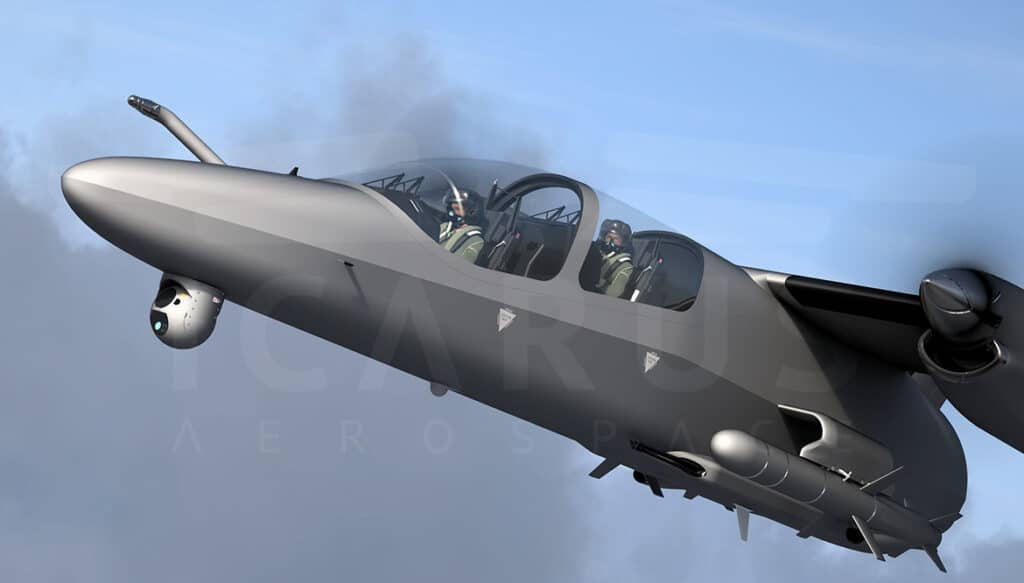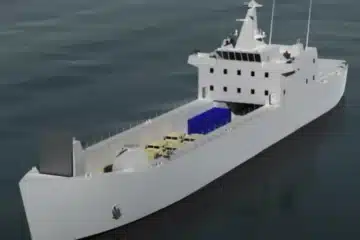For speculative discussion purposes, the author recommends the Icarus Aerospace Tactical Air Vehicle (TAV™) for a U.S. Marine Corps’ (USMC) light attack plane. The author reached out to Icarus Aerospace and spoke to company representatives who declined to provide much comment, citing that the TAV™ is in its nascent stages and that all design and conceptual performance information about the TAV™ is on its webpages. This author is not affiliated with this company or its products.
The TAV™ is a totally “clean slate drawing board design” that has no prototype or flying aircraft. Thus, the USMC can customize the TAV for carrier operations, install an armored cockpit with ejection seats, and include whatever modifications that the USMC deems suitable and necessary when the plane is still on the drawing board.

The author has also examined the Bronco II light attack plane and surmised that this single-engine two-seater propeller plane to be sufficient, respectably, but lacks certain features that an “on paper” designed TAV could offer for the Marine Corps such as twin engines, a larger payload, more room, more performance and endurance, radar, more hardpoints, and more range. The USMC would really need a multi-role, multipurpose, and multiple domain light attack plane and having redundancy in twin engines, twin tails, twin Forward Looking Infra-red (FLIR) retractable turrets, two pilots, and multiple hardpoints is vital in the unforgiving domains of vast stretches over land and sea.
The Marines will really need a plane that can fulfill their “Wish list” of desires for Close Air Support (CAS), Close Air Defense, Combat Search and Rescue (CSAR), Electronic Warfare/Jamming, C4ISR, Anti-Submarine Warfare (ASW), Anti-Surface Warfare (ASuW), deep penetration strike, loiter, counter-insurgency operations (COIN), drone control and operations, long-range precision ordnance carrier, Forward Air Control, tanking, Area Denial, Special Operations coverage, and other duties that their fighter/bomber F-18C/Ds and stealthy F-35Bs cannot achieve. The TAV™ can achieve these duties with one airframe modified for various roles at a lower cost and speed than the faster fighter jets that the U.S. Marines possess. Furthermore, the TAV can carry a gun whereas the F-35B requires an optionally-mounted centerline gunpod, compromising F-35B’s stealth, and rumors circulate that the F-35B’s gunpod is inaccurate.

Like the OV-10 Bronco of Vietnam-era fame, the TAV™ has two engine fuselages and a wide-body crew fuselage for added stability and survivability. The split engines should aid in infra-red suppression and also increase the surface area for installing chaff and flare dispensers and potential electronic jammers and early warning and missile detection systems.
The small Leonardo® Osprey Surveillance AESA radar panels can offer the TAV 360-degree radar coverage and the ability to search, identify, and track air, land, and sea targets for engagement with radar-guided munitions, thus offering a much better situational awareness characteristic of active AESA and (two) passive FLIR sensors that no other light attack plane can match. In theory, the AESA radars should give the Marines the ability to mount and fire AIM-120 AMRAAMs with modifications to the conceptual drawing board design, again an AMRAAM capability that no other light attack plane can achieve. An inquiry to Leonardo confirming this was returned stating that they cannot discuss combat capability and to consult the end-user of the Osprey radar.

The 11 hardpoints provide the ability to carry laser-guided bombs, IR AIM-9 air-to-air missiles, sonobouys and two torpedoes, GPS-guided munitions, and various rockets and other ordnance up to 8,000 pounds (3,628 kilograms). The TAV can also be outfitted with a forward fixed cannon and a 360-degree ball turret gun (up to 30mm caliber). These features should provide the Marines with a flexible, adaptable, and survivable multi-mission force multiplier aircraft to remedy the firepower missing from Force Design 2030 system divestments. In addition, the TAV’s unrefueled range with a 45-minute fuel reserve is 6.5 hours out to 1,300 nautical miles (1,496 miles or 2,407 kilometers) or 9 hours out to 2,000 nautical miles (2,301 miles or 3,704 kilometers) with external tanks, a huge range advantage when it comes to ASW patrols and CAS in remote areas of the world.

When the Navy’s aircraft carriers are paired with Expeditionary Strike Groups (ESGs), the USMC’s V-22s will finally have a propeller warplane that is fast enough and can provide CAS and V-22 escort coverage, while armed with close air-to-ground and air-to-air ordnance. (USMC helicopters are considered too slow and short-ranged to achieve these V-22 escort missions). This would free up the faster USMC F-18s and F-35s to provide Combat Air Patrols, deep strike, and interceptor/interdiction missions. Furthermore, the ability to control a “Loyal Wingman” TAV drone means that the TAV has the range, endurance, and loiter time to send in the drones to strike first, leaving the manned TAVs out of harm’s way and to survey the battle and damage from afar.
With the Icarus Aerospace TAV, the USMC can achieve operational advantages missing from “pointy-nose fast fighter jets.” The “twin redundancy in design” provides a degree of reliability and survivability that no other propeller-driven light attack plane, manned or unmanned, on the market can achieve. The TAV design may be the “Swiss Army Knife” for future USMC Aviation (and potential U.S. Joint Forces from U.S. Air Force to U.S. Special Operations) and fulfill mission requirement gaps from the S-3 “Viking” and EA-6B “Prowler’s” retirements.







